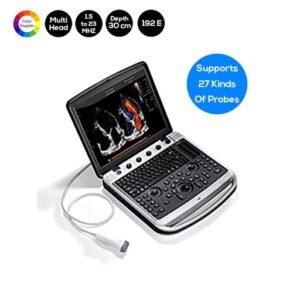Ultrasound-Guided Fine Needle Aspiration Biopsy of the Thyroid
Ultrasound-guided fine-needle aspiration biopsy (FNAB) is a reliable, minimally invasive diagnostic method with high sensitivity and specificity in the evaluation of thyroid nodules or abnormality such as papillary thyroid carcinoma within the thyroid and remove a tissue sample for examination under a microscope. The procedure is less invasive than surgical biopsy, leaves little to no scarring and does not involve exposure to ionizing radiation. suggestive of malignancy.
Nodule development is a commonly seen entity in the thyroid gland, and 4–7% of the adult population has a palpable thyroid nodules. With imaging modalities, especially the widespread use of ultrasound, nonpalpable thyroid nodules are being detected in 19–70% of the population. While ultrasound has a high sensitivity in detecting thyroid nodules, it is not sensitive enough in differentiating between benign and malign nodules.
According to the WHO classification system, papillary thyroid microcarcinomas (PTMCs) are PTCs <10 mm in diameter. Early cancer detection and intervention has been suggested to reduce patient’s mortality and morbidity. Given its minimal invasiveness and technical simplicity, ultrasound-guided fine-needle aspiration biopsy (US-FNAB) has been widely adopted for characterizing thyroid nodules cytopathologically The cytology results will help to determine whether or not subsequent thyroidectomy is necessary. According to the American Thyroid Association (ATA) guideline, US-FNAB is recommended for those thyroid nodules with a diameter >10 mm those with intermediate to high suspicion US pattern. On the other hand, for patients with nodules ≤10 mm of suspicious US pattern, active sonographic surveillance is recommended instead.
The needle used is a thin, fine-gauge needle that is smaller in diameter than the needle used in most blood draws (usually a 25 or 27 gauge 1.5 inch needle). The aspiration may be done with a needle or with a needle that is attached to a syringe. The syringe may be in a plastic or metal holder to make it easier for the doctor to aspirate the cells.
The use of US-guidance for FNAB allows real-time visualization of the needle, but is also highly operator-dependent. Physicians from many specialties (endocrinologists, otolaryngologists/endocrine surgeons, nuclear medicine physicians, radiologists, and pathologists) are involved in the diagnostic workup of thyroid nodules and a standardized and meticulous technique for US-FNAB is essential for lowering the yield of nondiagnostic specimens and false-negative results. A linear 7.2–14 MHz probe and 26G fine needle are often used.
Despite the high accuracy of FNAB in the detection of malignancy, the percentage of inadequate samples is around 10%, and in some centers this rate remains as high as 20–34%. Repeated biopsies due to inadequacy can lead to patient anxiety, increased costs, and unnecessary surgery. Thus biopsies should be executed under the guidance of a reliable advanced performance ultrasound. The ultrasound system should offer superior imaging and detail, designed to optimize viewing, and to provide an ergonomic workplace of Physicians from many specialties.
For this delicate procedure we highly recommend the Color Doppler Laptop Multi-Head Ultrasound Scanner SIFULTRAS-6.6 along with the L7SVA-V Linear Probe to minimize inadequate samples . This scanner uses the latest advances in transducer technology, which has wider bandwidth, higher sensitivity and better signal-noise ratio, providing superb anatomic details to users, delivering excellent resolution, especially during delicate-patient scanning such as in the case of Fine Needle Aspiration Biopsy of the Thyroid.
This procedure os performed by an elligible endocrinologists*

